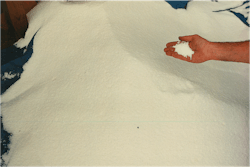What First Responders Need to Know About Ammonium Nitrate
Ammonium nitrate, a common agricultural fertilizer, is best known as an ingredient in the explosive that was used in the World Trade Center bombing in 1993 and the Oklahoma City Federal Building bombing in 1995. It is a material that can be found in and transported through many communities all over the United States and other countries.
More than a dozen explosions involving ammonium nitrate have occurred over the past century. The deadliest was exactly 65 years ago this week on April 16, 1947, when a series of explosions began with a blast on the SS Grandcamp, filled with more than 2,000 tons of ammonium nitrate fertilizer in Texas City, TX, just southeast of Houston. That explosion set fire to the SS High Flyer, which was 600 feet away from the Grandcamp and that was carrying 900 tons of ammonium nitrate fertilizer. The SS High Flyer also exploded.
Altogether, at least 576 people were killed and 5,000 were injured. Among the dead were all 27 of the Texas City firefighters who had responded to fight the fire and all of their apparatus was destroyed as well. Only one remaining Texas City Firefighter escaped death because he was not at the fire.
Other incidents have occurred in Rosebud, OR, in 1959 where 14 people were killed; in Kansas City, MO, when six firefighters were killed in 1988; and four people were killed in Port Neal, IA, in 1994.
Ammonium nitrate, NH4NO3, is an inorganic solid material classified by the U.S. Department of Transportation (DOT) as an oxidizer that can be an explosive by itself under certain conditions. It is hard to initiate under normal conditions, but response personnel should still deal with ammonium nitrate incidents with a great deal of caution. Subjected to confinement or high heat, ammonium nitrate may explode, but does not readily detonate. Fertilizer-grade ammonium nitrate, which is a strong oxidizer above 33.5%, may also explode if it becomes contaminated with organic materials.
When ammonium nitrate explodes, it produces a type of explosion referred to as a deflagration. Deflagration is a rapid auto combustion that occurs at a subsonic speed, less than 1,250 feet per second. The solid material changes to a gas relatively slowly. A material that deflagrates is considered a low-yield explosive.
A material that is designed to deflagrate may, however, under the right conditions produce a detonation. A detonation occurs when a high explosive changes from a solid to a gas almost immediately. A high explosive is detonated by heat or shock, which sets up a detonating wave that travels at supersonic speeds. This sudden creation of gases and the extremely rapid extension produces a shattering effect that can overcome great obstructions.
Ammonium nitrate is listed by the DOT as a Class 1.5 Insensitive Explosive, designed to produce a deflagration. The ammonium nitrate-fuel oil mixture involved in the Kansas City explosion that killed six firefighters was on fire and, as a result, produced a detonation that might have been caused by the application of water by the firefighters.
Commonly used commercially as an explosive, ammonium nitrate is mixed with other explosives or fuels that make it a more effective and potentially dangerous explosive. Ammonium nitrate is a strong oxidizer and the primary component of ANFO, a commercially available explosive material. Ammonium nitrate is a colorless or white to gray crystal that is soluble in water. It decomposes at 410° F (210°C), releasing nitrous oxide gas.
The four-digit UN identification number is 1942 with an organic coating, and 2067 as the fertilizer grade. There are a number of other mixtures of ammonium nitrate that have four-digit numbers; they can be found in the Hazardous Materials Tables and in the DOT's Emergency Response Guide Book.
ROBERT BURKE, a Firehouse contributing editor, is the fire marshal for the University of Maryland-Baltimore. He is a Certified Fire Protection Specialist (CFSP), Fire Inspector II, Fire Inspector III, Fire Investigator and Hazardous Materials Specialist, and has served on state and county hazardous materials response teams. Burke is an adjunct instructor at the National Fire Academy and the Community College of Baltimore, Catonsville Campus, and the author of the textbooks Hazardous Materials Chemistry for Emergency Responders and Counter-Terrorism for Emergency Responders. He can be contacted at [email protected].






